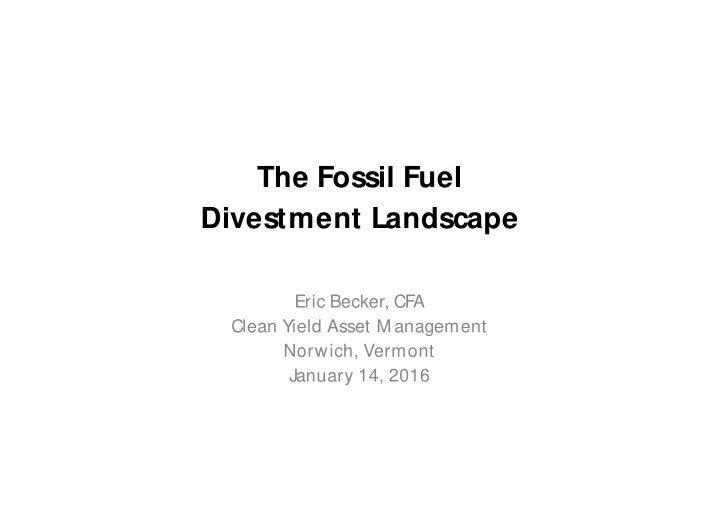



The Fossil Fuel Divestment Landscape Eric Becker, CFA Clean Yield Asset M anagement Norwich, Vermont January 14, 2016
The Carbon Bubble IEA: T o keep warming < 2° C “ 65% to 80% of listed companies’ reserves cannot be burned unmitigated.” http:/ / fossilfreeindexes.com/ 2014/ 05/ 06/ the-allocated-carbon-budget/ “Unburnable Carbon 2013: Wasted capital and stranded assets.” Carbon Tracker Initiative in collaboration with Grantham Research Institute on Climate Change and the Environment.
The Carbon Bubble “ In financial terms, we estimate that the value of unburnable reserves could amount to over $100 trillion out to 2050.” – Citi Equity Research, August 2015
The Economic Incentive for Action
The Carbon Budget Since there is a hard limit to how much carbon can be emitted without catastrophic results (both ecologically and economically), the global community is moving toward imposing a carbon budget. This budget entails significant risks for owners of fossil fuel reserves. Generation Investment M anagement identifies the primary risks as: Regulation (including mandates for efficiency and clean • energy) M arket Forces (e.g. cheaper clean energy) • Sociopolitical Pressures •
Risk/ Return Impacts of Divestment
USFossil Free Index Risk/ Return
EAFE Fossil Free Index Risk/ Return
$3.4 Trillion committed to divestment COLLEGES/ UNIVERSITIES PENSION FUNDS FOUNDATIONS College of the Atlantic California Public Employees’ Retirement Divest-Invest Philanthropic Group Georgetown University System (CalPERS) Rockefeller Brothers Fund Green M ountain College California State Teachers’ Retirement Sierra Club Foundation Hampshire College System (CalSTRS) Wallace Global Fund Naropa University Jubitz Family Foundation City of Providence, RI Pitzer College Educational Foundation of America United M ethodist Church General Board Prescott College Park Foundation of Pension and Health Benefits San Francisco State University Russell Family Foundation Stanford University Compton Foundation Sterling College RELIGIOUS INSTITUTIONS KL Felicitas Foundation Syracuse University United Church of Christ – National The Chorus Foundation Unity College World Council of Churches Singing Field Foundation University of California Lutheran World Federation Nia Community Foundation University of Glasgow M assachusetts United Church of Christ John M erck Fund M innesota United Church of Christ Joseph Rowntree Charitable Trust CITIES Evangelical Lutheran Church of Oregon Solidago Foundation Seattle, WA First Unitarian Church of Salt Lake City Jessie Smith Noyes Foundation San Francisco, CA First Parish Unitarian Universalist Church Granary Foundation Portland, OR in Cambridge, M A The Schmidt Family Foundation Eugene, OR First Unitarian Church of Pittsfield, M E Ben & Jerry’s Foundation Berkeley, CA First Unitarian Society of M ilwaukee, WI Pax Fund Boulder, CO First Presbyterian Palo Alto, CA Threshold Foundation M adison, WI Dover Friends M eeting, Dover, NH Ithaca, NY Unitarian Universalist Society of Provincetown, M A Amherst, M A Providence, RI M aine Council of Churches, M E Cambridge, M A
Investment Options Indexes have rolled out over past 18 months • S&P 500 Fossil Fuel Free Index • FTSE/ Blackrock – N. America and All-World Indexes • M SCI ACWI (All Country World Index) • Fossil Free Indexes (Former S&P executives) M anaged accounts • Blackrock (FTSE ex-Fossil Fuels Index Series) • Parametric (Fossil Free Indexes USand EAFE) • Aperio Group (custom screening) • Trillium Asset M anagement (custom screening) ETFs SPYX – S&P 500 Fossil Fuel Free SPDR – 0.20% exp. ratio •
Summary The Carbon Bubble presents significant risks to owner of fossil fuel reserves as pressure increases to limit the burning of fossil fuels. There is no evidence of a return penalty for divesting from fossil fuel companies. Fossil fuel free index returns show comparable or lower risk than their benchmarks. 500+ institutions with $3.4 trillion in assets have committed to divest. Fossil free investment options are quickly emerging for institutional investors.
Recommend
More recommend